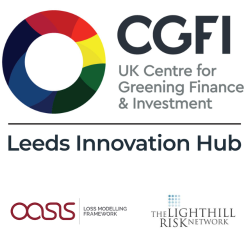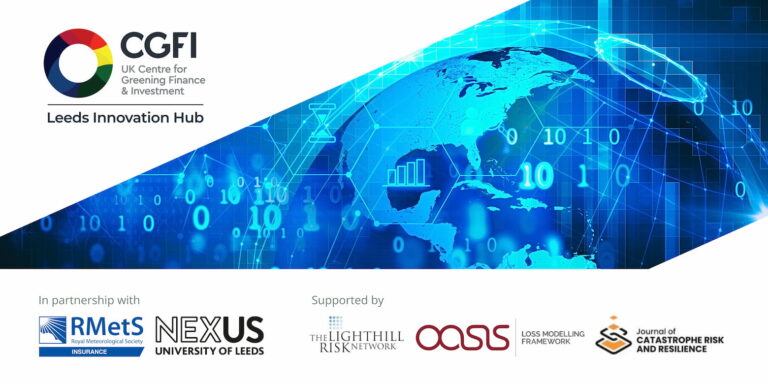Table of Contents
The UK Centre for Greening Finance and Investment (CGFI) Leeds Innovation Hub, in collaboration with the Royal Meteorological Society (RMetS), hosted an event on the biggest climate related challenges facing the insurance sector. This was hosted at NEXUS, University of Leeds, on Wednesday 6th March 2024.
Working with the Lighthill Risk Network, Oasis LMF and Journal of Catastrophe Risk and Resilience, we identified four of the biggest challenges facing the sector in the coming years:
- How much physical risk can already be attributed to climate change, and what level of future risk is already locked in?
- High-resolution information and downscaling
- Potential for improved decadal scale forecasts
- Climate tipping points
To meet these head on, it is crucial that cutting edge climate science and practical applications in insurance are aligned. This event facilitated detailed discussions between academia and industry, with the aim of setting out a research agenda for the most needed and best quality science.
Event and news contact: Leeds Innovation Hub Manager – Trish Grant (p.grant@leeds.ac.uk)
Key findings

- Assessing the attribution of current and future physical risks to climate change poses a significant challenge due to complexities in historical loss data and biases in climate models.
- High-resolution climate data and downscaling techniques are crucial for accurate risk assessment, alongside improved vulnerability and exposure information, but resource limitations and model biases need to be addressed to enhance credibility.
- Improved decadal scale forecasts provide valuable insights for understanding long-term climate risks, but collaboration is essential to ensure their usability and acceptance within the insurance sector.
- Proactive mitigation strategies and collaboration between academia and industry are essential for addressing complex climate tipping points and building resilience against potential scenarios.
Through presentations and panel discussions, attendees delved into topics such as the attribution of extreme weather events to climate change, downscaling methods, and the potential impacts of climate tipping points. The discussions underscored the importance of collaboration between academia and industry, where both groups respectfully listen and learn from one another to develop research agendas and practical solutions. Moving forward, UK CGFI Leeds plans to continue engaging stakeholders and facilitating coordination to address these challenges effectively, with a follow-up online session scheduled for the third quarter of 2024 to maintain momentum and involvement.
Introduction

There is a growing recognition of the need to include climate change within estimates of physical weather-related risks within the insurance industry. The UK CGFI Leeds Innovation Hub, in collaboration with the Royal Meteorological Society (RMetS), hosted an event on the biggest climate related challenges facing the insurance sector. 95 people attended, with 45 from the insurance industry.
Prof Iain Clacher (Leeds Innovation Hub Director, UK CGFI) welcomed attendees to the hub and highlighted its missions to connect UK climate science and innovation in analytics with financial institutions.
Dr Matt Priestley (RMetS Science Engagement Fellow and University of Exeter) outlined the scale and scope of the ongoing work from RMetS around establishing challenges around usage of weather and climate data in the insurance industry and collaboration with academia. RMetS supported this event as it aligns with their wider objectives on discussing and strengthening the current research agenda, bringing researchers from different sectors together, and informing the wider community on the latest science.
Dickie Whitaker (Oasis LMF and Lighthill Risk Network) outlined the four key challenges to be discussed, highlighting that these were selected from a list of ten that the insurance sector presented to UK CGFI. The aim of the event was to start the conversation on how industry and academia could collaborate to address four of the most pressing physical climate risk challenges facing the sector in the coming years. The objective was to make decisions on the next steps, how to define the challenges, and identify potential collaborative research pathways to address them.
Challenges
Challenge #1 - How much physical risk can already be attributed to climate change, and what level of future risk is already locked in?

Whilst much of the focus on climate change tends to be through a future lens, very little attention is paid to how much risk may have changed already. Validation of catastrophe models often takes the form of contrasting their output with historical data, but very little is done in validation to show how risk may have changed up to the present day to validate that the view of risk presented by the models is genuinely up to date.
Some of the issue comes from the fact that we are hamstrung through use of historical data: tail risk trends simply cannot be spotted in short 50- or 100-year historical datasets. If we are able to use – and potentially be involved in the design of – more ensemble climate modelling in reanalysis of the past, we can help ourselves to understand how risk is shifting up to the present day and also feel comfortable that the numbers presented by the catastrophe modelling companies are genuinely a reflection of present-day risk. Having multiple counterfactual analyses of prior years’ also may potentially help towards disentangling natural variability from climate deltas. There is also the additional possible role of including population and land use change into historical risk shift considerations to help identify where increasing historical losses could be more influenced by demographics than climate change and can lead to confusion over the size of the climate delta.
Dr Richard Dixon (Inigo Insurance) highlighted in his presentation that we cannot currently spot trends in loss data in the historical record because such data often conceals trends due to its nature. Loss data often hides trends, and small shifts in an underlying distribution often have a huge impact on the resultant loss, with amplified tail impacts. Additionally, models currently say little about changing background risks. Ensembles and counterfactuals help us understand these shifts in risk – using counterfactual data shows background risk has been increasing, with the greatest shifts often on the edge of currently risk-prone areas.
Prof Myles Allen CBE FRS (University of Oxford) presented on the history and background to the attribution of extreme weather events to climate change. He highlighted the potential role of seasonal to sub-seasonal (S2S) forecast models in attribution studies alongside other ensemble techniques, with the example of the extreme weather events of 2013/14 winter, for which an attribution study found higher return periods for all return levels and a ~40% increase in risk.
The subsequent panel additionally included Sandra Hansen (Guy Carpenter), Prof Ralf Toumi (Imperial College London) and chair Jessica Boyd (WTW). The panel discussed how natural variability versus the influence of climate change is generally not well understood for major perils. Uncertainty from random error (variability) and bias must also be known. Risk estimation methodologies employ downscaled output from general circulation models (GCMs) to provide high-resolution information on climate variables. These downscaled climate model outputs complement numerical weather prediction (NWP) models, and both offer spatially detailed simulations of specific weather phenomena. However, these must be used in an informed way. This includes understanding what, for example, period GCMs are trained on and what biases are included.
Panellists also highlighted the role of ensembles and other sources of data to fully understand historical events and the impact of climate change. Key next steps could be to explore how S2S and NWP data can be used for the industry in quantifying risk, and to assess the usage of large ensembles for understanding historical risk.
They identified challenges including pushing research further into compound events, and the tail (though confidence in data decreases as this is done). Metrics and assessments also vary between sectors, baseline periods are inconsistent, and some scenarios are not of interest to industry – RCP8.5 in 2100 as one example.
(Session scribe: Dr Matthew Priestley, RMetS)
Challenge #2 - High resolution information and downscaling

The need for downscaling is due to the models not simulating extreme events of interest. They do not simulate these events out of error but largely because it is not numerically possible at their coarse resolution. Proposed solutions include increasing the resolution of global climate models or using regional climate models (IPCC_AR6_WGI_Chapter08, p. 85). Statistical downscaling is a form of bias correction which critically assumes that the same scaling can be done to both historical and future data sets.
The other main challenges in downscaling from climate models include the weak coordination of production of downscaled datasets, which leads to significant errors in high-resolution downscaled reconstructions of the current climate (IPCC_AR6_WGI_Chapter10, p. 15). Additionally, integrating these downscaled datasets with historical change and process-based understanding remains an important challenge (IPCC_AR6_WGI_Chapter10, p. 15). The ability to project all aspects of shifting climate impact driver profiles and their effects at fine, local scales is often reliant on dynamical downscaling and additional impact modelling steps, making the quantification of uncertainties more challenging (IPCC_AR6_WGI_Chapter12, p. 103). The evaluation of the added value of downscaling is complex (IPCC_AR6_WGII_Chapter11, p. 10). The coarse spatial resolution of climate models has also been considered a limitation, and proposed solutions include increasing the resolution of global climate models or using regional climate models (IPCC_AR6_WGI_Chapter08, p. 85). Ref: https://www.nature.com/articles/nclimate3418
Presenter Dr Paul Young (JBA Risk Management) discussed high-resolution information, and how new paradigms for credible high-resolution data are needed both spatially and across timescales. At the same time, a high-resolution atmosphere risks a disconnect with, for example, the resolution possible for the land surface. While the latter is important for the hydrological cycle, it is more heterogeneous than the atmosphere and less amenable to modelling at higher resolution. Approaches should include an understanding of uncertainty and we should not forget the importance of exposure and vulnerability. However, resources are limited, so we need to be pragmatic – and defensible – in our approaches.
Dr Ségolène Berthou (Met Office) discussed k-scale climate information (i.e., at ~1 km resolution), particularly important to understanding hazards that are dependent on the accurate representation of convection (including tropical cyclones, hail and sting jets). This data can be produced by dynamical downscaling (for example of the UKCP18 global data to UKCP18_local); statistical downscaling; or machine learning. k-scale modelling is currently expensive, and science in this space is pioneering and focused on particular regions. Machine learning may bring down the computational costs.
Prof Ralf Toumi (Imperial College London) presented on downscaling, and highlighted methods and challenges to progress in downscaling. These include reliability of higher resolution data and physical model ensembles (preferred but difficult to access); nested high-res models (accessible but introducing bias at the boundary); statistical models including machine learning (useful for points but cannot then be used for regions without training). He highlighted the value of bringing in physics understanding to the use and interpretation of statistics.
The subsequent panel, chaired by Prof Hayley Fowler (Newcastle University), also included Prof John Marsham (University of Leeds) in a discussion on trade-offs in model resolution, ensemble size and domain size, which could potentially become less of a trade-off if machine learning can be harnessed to help with downscaling. They highlighted that high-res models do not only bring high-resolution detail, but the high-resolution processes have upscale impacts that may improve accuracy up to the global scale: high-resolution models still do not solve all process errors of course, e.g. recent work has shown how some can struggle to accurately represent the response of convection to vertical wind shear.
The panel discussed how insurance would like to identify “unseen” events, and that machine learning needs further evaluation for this . Further, climate services need to engage insurers to ensure users understand models and products.
Key next steps would involve further research and development efforts to tailor machine learning algorithms specifically for identifying “unseen” events in the context of insurance risk assessment. Additionally, climate services should actively engage insurers to ensure a clear understanding of the models and products available, fostering collaboration to refine existing models and develop new tools that meet the evolving needs of the insurance industry. Finally, we should not forget the importance of improved and higher-resolution vulnerability and exposure information for better risk quantification.
Session scribe: Dr Hannah Bloomfield, Newcastle University)
Challenge #3 - Potential for improved decadal scale forecasts

There is a need for a business risk view on the 5 -10 year time scale. However, this sub-decadal time scale is somewhat neglected by research lying between seasonal and long-term climate change. Yet the path to climate change can be expected to include decadal fluctuations which will have a business impact. There is a research gap around decadal predictions and variations of the important modes NAO, AMO, PDO, ENSO etc on decadal timescales. It is not clearly understood how these modes change as the mean state shifts. This is a hard problem as the sub-decadal timescale is in a “grey-zone” which is less constrained by the current ocean surface temperature (important for seasonal) or aerosols and greenhouse gases (important for climate projections).
Dr Adrian Champion (Aon) spoke on natural variability in global economic losses and between countries, and huge variability in tail events. He also highlighted the need for CAT models to capture changes in losses with climate change, and over the next ten years.
Dr Leon Hermanson (Met Office) noted the opportunity to harness large multi-model ensembles. He mentioned that climate services could be built taking advantage of windows of opportunity when climate is more predictable. This could be done using simple relationships between what is skilfull in the model and what is needed by the client. Another way could be physics-informed machine learning with embedded transparency (which means that the machine learning models incorporate mechanisms to make their decision-making processes understandable and interpretable). He discussed the gap between the seasonal forecast and multiannual forecast, and highlighted methods such as UNSEEN which can combine seasonal and decadal predictions. When compared with observed data, these simulation approaches can be used to identify tail events; help predict climate models like ENSO (El Nino) associated with weather extremes; and look at non-linear processes.
The panel discussion, chaired by Dr Nick Leach (University of Oxford), was joined by Dr Paul Wilson (Securis Investment Partners LLP) and Dr Dan Bernie (Met Office). The panel noted that despite the meteorological accuracy of forecasts, their usefulness from a loss perspective remains limited in industry. A major challenge lies in linking large-scale modes and their predictability to actual losses. Despite efforts to incorporate decadal forecasts into CAT models, there are limitations in methodology and acceptance within the industry, particularly in regulated markets.
Companies that purchase forecasts need to understand their quality for specific applications. Insurance contracts are often renewed at the beginning of the year, so understanding forecasts around those timeframes becomes particularly crucial. In general, tools are needed to assess and utilise forecast information effectively within the insurance industry’s workflow and tailored to industry needs.
Key next steps involve fostering collaboration among forecast centres, academia, and industry stakeholders through various means such as research projects, workshops, conferences, and platforms for sharing best practices. This collaboration can address the geographical limitations of forecast information by improving the applicability of forecasts to different regions and risk profiles.
(Session scribe: Dr Dhirendra Kumar, University of Reading)
Challenge #4 - Climate tipping points

In climate science, a tipping point is a critical threshold that, when crossed, leads to large, accelerating and often irreversible changes in the climate system.[1] If tipping points are crossed, they are likely to have severe impacts on human society and may further accelerate global warming.[2][3]
Tipping behaviour is found across the climate system, in ecosystems, ice sheets, and the circulation of the ocean and atmosphere.[3]
Armstrong McKay et al. (2022) identified 16 distinct tipping points, noting that 5 of them may have already passed critical warming thresholds. That is to say, at least 5 may already be in the process of occurring, with no recourse for prevention. At present, tipping points are not included in any market-deployed catastrophe risk models, yet they define the truly catastrophic and systemic risks of climate change. While probabilities of any single tipping point occurring may seem remote, it is yet to be tested whether the probabilities, time horizons and impacts of occurrence imply that they now fall within typical insurance focused return periods and risk transfer products, or whether they will begin to in the near future. Further, it remains to be studied how the tipping points may be correlated, and if the joint probabilities of occurrence warrant explicit treatment of multiple tipping point occurrence in catastrophe risk models available to the insurance industry.
In the final session, Prof Jason Lowe OBE (Met Office / CGFI / University of Leeds) outlined difference between possible tipping point dynamics – such as abrupt changes (AMOC collapse), irreversible changes (Greenland ice sheet collapse) and positive-feedback tipping points that increase future climate change (forest loss). He highlighted that tipping points and their triggers remain uncertain, but because processes are now better understood, we can design better early warning systems. We also need to better understand “temporary resilience”. Research is ongoing on how long thresholds can be passed without triggering tipping points – important as many optimistic scenarios still overshoot temperature thresholds.
Dr Bablu Sinha (National Oceanography Centre) detailed the tipping point potential of the Atlantic meridional overturning circulation (AMOC), the main circulation of the Atlantic Ocean. The AMOC depends on cold, highly saline water sinking at high latitudes. As the ocean surface warms and freshwater is released from melting ice, all (AR6) models show the AMOC will weaken. While some climate models depict a complete collapse of the Atlantic Meridional Overturning Circulation (AMOC) under extreme warming scenarios, the scientific consensus suggests such a scenario is unlikely in the near future. However, paleoclimate proxy data indicates past AMOC weakening or even collapse during certain periods, such as the Pliocene epoch. This would have major impacts on European temperatures, tropical rainfall, monsoons and regional sea level.
Finally, Dr John Wardman (Maximum Information) proposed a collaborative approach to climate tipping points. He noted that CAT models peril-region focussed and lack a systemic view; multi-disciplinary research on tipping points is needed and industry must adapt to these complex and interconnected risks. Academia can offer scientific expertise to assess likelihoods, identify early warning signs, and create robust scenario planning frameworks for tipping points.
The panel discussion, including chair Prof Viktoria Spaiser (University of Leeds), Amir Sethu (MS Amlin) and Dr Cameron Rye (WTW), concurred with previous panels on the need to think about tipping points in the terms of insurance industry. This would include considering how tipping points and resilience measures can fit with industry timescales; considering tipping points within markets where insurers may pull out entirely; and positive tipping points in industry that may have implications for underwriting.
They also discussed building tipping points into CAT models (where they could explain smaller-than-expected impacts). This could require additional data layers, rather than only calibration. They discussed the need for future work on tipping points such as rainforest dieback, that represents the physics of tipping points. Finally, they called for collaboration between industry and academia, including a common language.
Key next steps include incorporating tipping points into CAT models to explain smaller-than-expected impacts, potentially requiring additional data layers beyond calibration. Future work on tipping points, such as rainforest dieback, representing the physics of tipping points, is also emphasized. Furthermore, collaboration between industry and academia, facilitated by sessions at the CGFI forum and dedicated follow-up expert meetings on tipping points, is recommended to establish a common language and advance understanding in this critical area.
(Session scribe: Dr Mark Bernhofen, University of Oxford)
Next Steps

Patricia Grant, Innovation Hub Manager, has reaffirmed her commitment to advancing the UK CGFI Leeds close collaboration with key stakeholders to develop collective strategies addressing each of the four challenges for sector-wide benefits.
- Follow-on events
- Online session, UK CGFI will provide updates on each challenge.
*Save the date – October 23rd, 2024, 10:30 to 12:00*… Express your interest in attending - In-person session, UK CGFI and Lighthill Network will reconvene with stakeholders to continue collaborating for impact.
*Save the date – March 26th, 2025, 11-19:00 – to be confirmed*
- Online session, UK CGFI will provide updates on each challenge.
- Collaborative projects, working with Oasis LMF, the Lighthill network, and the insurance sector to define a series of climate tipping points challenges for research projects to address.
- Direct stakeholders towards research initiatives, aiming to coordinate efforts and prevent duplication within the insurance and science communities.
Join our mailing list!
Sign up to our UK CGFI Leeds mailing list to receive our research updates, invitation to future events, and opportunities to collaborate.



